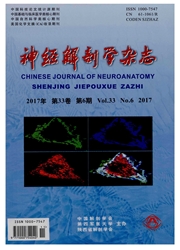

 中文摘要:
中文摘要:
本研究通过采用钙基因相关肽(CGRP)和小牛白蛋白(PV)分别标记胚胎15d(E15)到生后3d(P3)小鼠脊髓的痛温觉和本体觉两种初级传入纤维,观察了这两种纤维在小鼠脊髓内投射和终止的发育变化.结果显示:CGRP样免疫阳性(LI)纤维最早于E16出现在脊髓背角浅层,并在E17和E18时逐渐向背角外侧和深层终止.在出生后,CGRP-LI纤维在背角的分布特点无明显变化,但是在背角浅层的纤维数量进一步增加,分支状态更为复杂.另外,还在E16时开始出现向对侧脊髓背角发出侧支投射的CGRP-LI纤维,至生后早期,向对侧投射的纤维数量增多.PV-LI纤维最早于E15进入脊髓灰质.E16时,已有较多的PV-LI纤维到达中间带灰质和腹角.随着发育阶段的增长,脊髓腹角内PV-LI本体觉纤维和终末的数量和密度逐渐增加,并于生后早期(P0-P3)时达到最高水平.本体觉传入纤维的终末在E17时开始与脊髓腹角内的运动神经元形成密切的接触.本实验结果表明痛温觉和本体觉传入纤维在脊髓内的终止形成于小鼠胚胎晚期和生后早期,并具有时空特异性.这为深入理解感觉信息在脊髓传递和调节的形成过程提供了依据.
 英文摘要:
英文摘要:
The present study was designed to examine the developmental changes in projection and termination of nociceptive and proprioceptive afferent fibers in the spinal cord by labeling those two fibers with calcitonion gene-related peptide (CGRP) and parvalbumin (PV)separately in mouse embryos and neonatal pups aged embryonic day 15 to posanatal day 3 (E15 -P3). CGRP-like immunoreactive (LI)nociceptive fibers first appeared in the superficial dorsal horn (DH) at E16. The afferent projections extended laterally to the DH and entered into the deep portions of the DH at E17 and E18. After birth, the projection pattern of CGRP-LI fibers remained unchanged but the intensity of afferent terminals increased in the superficial laminae and their branching patterns became more complicated. In addition,CGRP-LI collaterals that projected into the contralateral DH were also examined after E16. Around birth, the contralateral projections were also found originated from the lateral part of the DH. PV-LI proprioceptive afferents were first observed entering the gray matter at E15 and reached the intermediate gray matter (IG) and the ventral horn (VH) more obviously on E16. The number and intensity of PV-LI fibers increased in the the VH with age and reached a maximum during earlier postnatal period ( P0-P3 ). The proprioceptive terminals seemed to form close relationship with motoneurons in the VH from E17. Our results indicate that the somatotopic organization of nociceptive and proprioceptive afferents in the spinal cord both are established during the late embryonic and early postnatal stages. These results help to understand the development of the sensory transmission in more details.
 同期刊论文项目
同期刊论文项目
 同项目期刊论文
同项目期刊论文
 期刊信息
期刊信息
